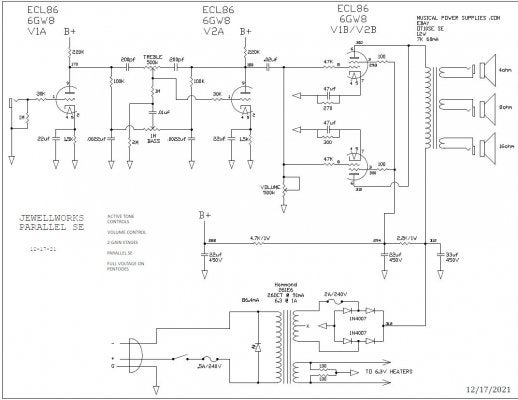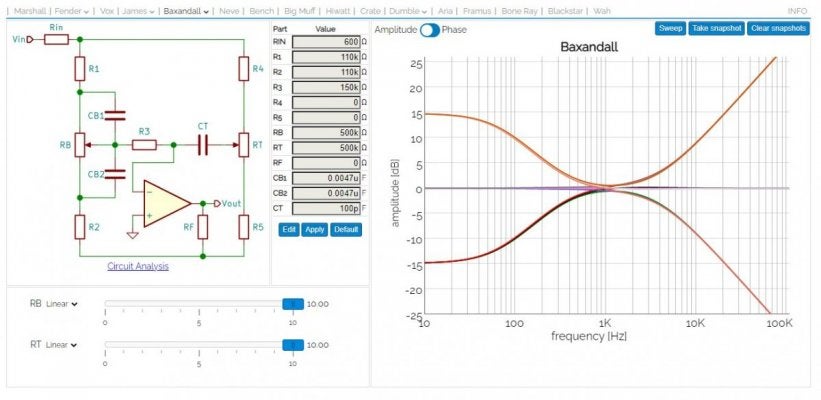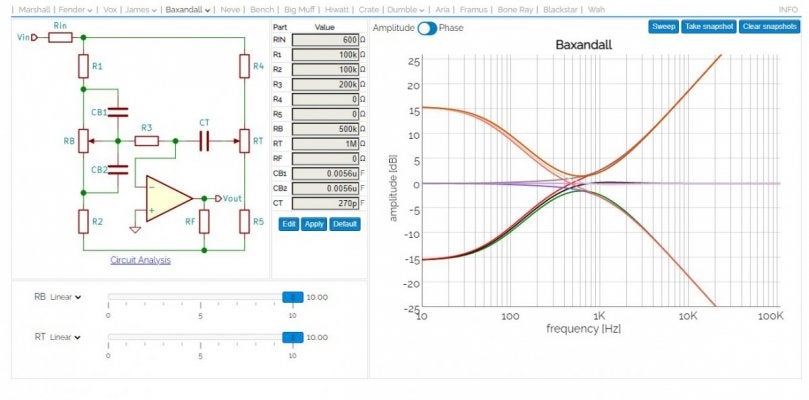Jewellworks
Tele-Holic
a while back, i created and built what i call my RicknDevil. 2, ECL86 tubes (triode/pentode) based on a Rickenbacker amp from 1938. very simple circuit, -input goes directly to the phase inverter which feeds the pentodes in P/P. overall, its a success, and ive been playing through it almost exclusively lately.
BUT..
it sounds and "feels" almost identical to another amp i made i call my Cyclops. 1, ECL86. triode feeds the pentode, -done. and ive been asking myself, WHY do i have 2 nearly identical amps? what can i do to make the RicknDevil a little more interesting, yet still use almost everything? and not reinvent the wheel along the way?
so i got to thinking about ACTIVE tone controls, and i looked up a few circuits. -how they're done, and (just as important) how they work.
almost all of them were using a cathode follower, which wouldnt work for me because id be loosing a gain stage. but i did come across 1 design that came off the plate. so i adopted that, and decided to go with a parallel SE output stage for my pentodes. see below...

what surprised me about this is, its not that much more complex than a regular passive tone stack, but you get so much more out of it. why isnt it used more? especially in the designs i see on this forum?
i can use practically everything in my original circuit (chassis, sockets, PT, jacks)... the only thing ill need to change is my OT, which is $42. -and components to reflect the new circuit. ill probably make a custom turret board. i bought everything to make one months ago.
i would be very interested in thoughts and opinions on this design, and on Active Tone Stacks in general. pros and cons
and as a side note, i was also getting a little bit of hum, and although its minimal, i thought id up the filter cap values to see if i can knock it back. i read Merlin's article on power filtering and i didnt realize that you can use much larger value caps when using a solid state rectifier. i plan on upping the caps in the Cyclops as well.
BUT..
it sounds and "feels" almost identical to another amp i made i call my Cyclops. 1, ECL86. triode feeds the pentode, -done. and ive been asking myself, WHY do i have 2 nearly identical amps? what can i do to make the RicknDevil a little more interesting, yet still use almost everything? and not reinvent the wheel along the way?
so i got to thinking about ACTIVE tone controls, and i looked up a few circuits. -how they're done, and (just as important) how they work.
almost all of them were using a cathode follower, which wouldnt work for me because id be loosing a gain stage. but i did come across 1 design that came off the plate. so i adopted that, and decided to go with a parallel SE output stage for my pentodes. see below...

what surprised me about this is, its not that much more complex than a regular passive tone stack, but you get so much more out of it. why isnt it used more? especially in the designs i see on this forum?
i can use practically everything in my original circuit (chassis, sockets, PT, jacks)... the only thing ill need to change is my OT, which is $42. -and components to reflect the new circuit. ill probably make a custom turret board. i bought everything to make one months ago.
i would be very interested in thoughts and opinions on this design, and on Active Tone Stacks in general. pros and cons
and as a side note, i was also getting a little bit of hum, and although its minimal, i thought id up the filter cap values to see if i can knock it back. i read Merlin's article on power filtering and i didnt realize that you can use much larger value caps when using a solid state rectifier. i plan on upping the caps in the Cyclops as well.







